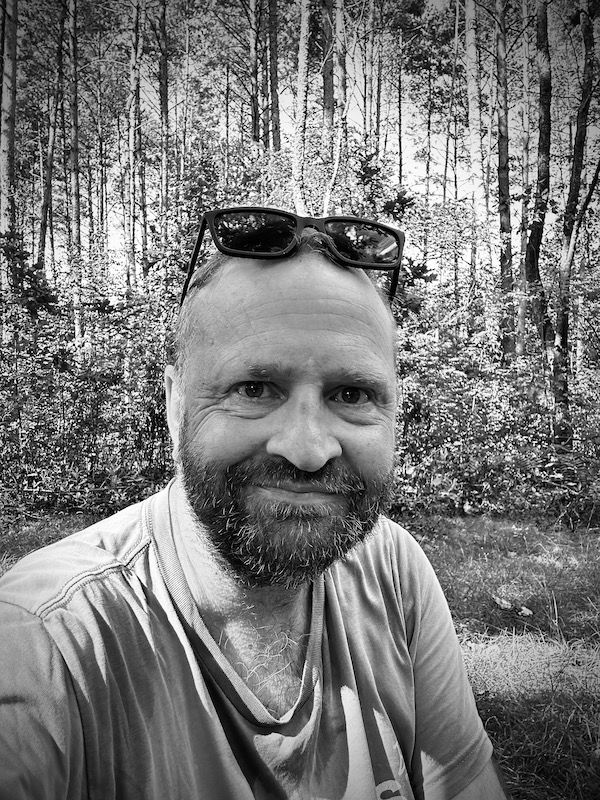Dear reader, I write these words at a rather curious juncture - standing on the threshold between my past pattern of brief, occasional visits to Warsaw and my imminent shift to extended three-month stays. My present thoughts emerge from a place of anticipation, a wondering about how this durational change might transform my relationship with place, with belonging, and with the very concept of home itself.
As I prepare for this transition, I increasingly find myself questioning what it means to create temporary roots while maintaining a nomadic identity. My trusty postmodern lens offers a way to make sense of these seemingly contradictory positions - to embrace the simultaneity of movement and momentary stillness, of familiarity and foreignness, of connection and detachment. So, I guess what follows is an exploration not just of where my heart might be, but how it moves through space and time. Strap in then, it could be quite a ride.
“Home is where the heart is.” The phrase slips easily from our tongues, a ready-made comfort for those between houses, between cities, between lives. But what does it mean when one’s heart refuses to settle? When it beats across timezones, pulses through temporary apartments, and rhythmically propels you onward every few months? I suppose it’s inevitable in this era of liquid modernity, that the solidity of “home” is dissolving into something more fluid, something more ambiguous.
The Decentered Self in Postmodern Space
You might have read my article on vernacular, where I sought help from Pierre Bourdieu’s concept of “habitus”, which suggests that we actually internalise social structures, and that our very being is shaped by the spaces and places we inhabit. Or you might not have. Anyway, my question is what happens when those spaces he refers to multiply and overlap? When Warsaw’s cobbles briefly imprint themselves on your soles before giving way to Coventry’s asphalt or Sarajevo’s hills? Surely, our postmodern condition must involve an incredulity toward meta-narratives - including, perhaps, the grand narrative of “home” as a singular, fixed point of origin and return.

It figures then, that my habitus is fracturing into a collection of dispositions that will shift and reconfigure with each new temporary dwelling. Right? I’ll no doubt find myself reaching for light switches that aren’t there, expecting doors to open in directions they don’t, momentarily forgetting which currency I’m using. All that jazz. This multiplicity of embodied knowledge speaks to what another minor hero of mine, Fredric Jameson, identified as the "postmodern experience of space" - a hyperspace where traditional perceptual coordinates no longer apply, where cognitive mapping becomes increasingly difficult.
Home as Practice Rather than Place
Perhaps home isn’t where the heart is, but what the heart does. The rituals I enact daily: that first cigarette in the morning, a similar routine whether in Warsaw or Leeds, the familiar arrangement of toiletries on unfamiliar bathroom counters, the tech I carry across borders. Surely these practices constitute a kind of portable habitus, a way of being-in-the-world that transcends geographical fixity. (Is that even a word?). Any postmodernist worth their salt would recognise these rituals as “tactics” - the everyday practices through which we appropriate and transform the spaces designed by others. My imminent nomadic existence will, by definition therefore, become a series of tactical manoeuvres, merely temporary appropriations of spaces never fully possessed. Comprendez?
True enough, the postmodern condition is one of fragmentation, of multiple, sometimes contradictory identities existing simultaneously. For me, existence as a perpetual foreigner - always learning new transport systems, always mispronouncing words, always the one asking rather than explaining - embodies this fragmentation. Maybe I will inhabit a “third space” between cultures, neither fully insider nor outsider, creating hybrid meanings and identities that exceed simple binary categories. Maybe not.
Each stint then, becomes a kind of “non-place” a transitory space where one remains anonymous, a space of passage rather than dwelling. Yet paradoxically, these non-places will become, collectively, my place.
The airports, the apartments with their identical IKEA furniture, the coffee shops with their predictable WiFi passwords - these homogenised spaces of globalisation will likely constitute my distributed dwelling.

The Privilege of Placelessness
Don’t get me wrong, this nomadism carries with it a certain privilege. The ability to move (more or less) freely (thanks for that, Dave Cameron) across borders, to choose temporary displacement rather than have it thrust upon you. Bourdy would, for sure, recognise this as cultural and economic capital at work - the passport that opens doors, the income that allows for three-month leases, the education that makes remote work possible. Haha, one could even describe this as “nomadology” (I love that) - a chosen deterritorialisation distinct from the forced deterritorialisation of the marginalised. Put that in your pipe and smoke it, I’m on a roll now.
Indeed, my "placelessness" is voluntary. For many, displacement is not a lifestyle but a wound. The refugee, the economic migrant, the climate displaced - their relationship to home is charged with loss and necessity rather than choice and exploration. Postmodernism’s celebration of fragmentation and mobility must be tempered with this awareness, the romance of nomadism, after all, surely dissolves when crossing borders becomes a matter of survival rather than self-actualisation?
The thing is, this contradiction embodies a type of “time-space compression” - the way technological and economic changes have accelerated the pace of life and diminished the significance of distance, creating both new freedoms and new inequalities. My ability to work remotely while living in various places represents one face of this phenomenon; the displaced person’s forced migration inevitably represents another. Both are products of the same forces, yet experienced radically differently based on one’s positioning within networks of power and capital.
This awareness creates a kind of double consciousness in my nomadic existence. Each new apartment, each new city, will come with the knowledge that my freedom to leave is precisely what others lack.
My transience is voluntary; theirs compulsory. My border crossings are frictionless; theirs fraught. This knowledge doesn’t invalidate my chosen lifestyle, but it contextualises it within the broader global dynamics of mobility and immobility. Like the division between “tourists” and “vagabonds”.

Warsaw: A Structure of Feeling
I digress. Let’s talk about Warsaw. I like doing that. There is clearly something in Warsaw that really tugs. Is it the familiarity of a language I’m working hard to learn? The rhythm of a city I’ve visited so often? The faces I recognise? These subtle pulls infer to me that even in perpetual motion, certain places exert stronger gravitational forces on our own orbiting hearts.
What I’ve developed for Warsaw is absolutely what Raymond Williams would call a “structure of feeling”- an elusive yet powerful sense of a particular quality of social experience and relationship, historically distinct from other qualities, which gives the feel of a generation or a period.
My structure of feeling for Warsaw exists in the interstitial spaces between formal belief systems and lived experiences, in the half-articulated sensations that arise when I walk its streets.
It manifests in subtle, embodied ways: how my breathing changes when I exit Warszawa Centralna, the railway station with its communist-era architecture now housing global retail chains - a perfect metaphor for Poland’s post-socialist transformation. It lives in my appreciation for Warsaw’s particular contradictions: its persistent memory of historical trauma juxtaposed against its relentless forward momentum; its stark Soviet buildings beside resurrected pre-war facades; its nostalgic milk bars serving traditional food alongside third-wave coffee shops. This city has experienced its own postmodern condition - rebuilding itself after near-complete destruction, creating a simulacrum of its former self in some neighbourhoods while boldly embracing hypermodernity in others.
Hold on though, what would my bestie, Bourdieu make of this? Well, I think he might suggest that my personal habitus recognises something in Warsaw’s fields of social interaction that resonate more deeply for me than with other cities. That my dispositions find their complement in its particular cultural capital, its aesthetic sensibilities, its modes of being.
But there’s also something more ineffable at work here too - something in the city’s rhythm, its light, its particular melancholy beauty that defies a more rational analysis.
What draws me to Warsaw may be precisely its resistance to easy categorisation - its refusal to be either entirely Eastern or Western, either stuck in history or hurtling into the future. For me, Warsaw embodies liminality, existing at thresholds between different versions of Europe, different economic systems, different historical eras.
This liminality mirrors my own soon-to-be nomadic existence, creating a harmonious dissonance, a recognition of shared in-betweenness.
What’s more, my feelings for Warsaw are heightened by impermanence. I never stay long enough for the romance to fade, for the daily irritations to accumulate into resentment. Each departure preserves Warsaw in amber, idealised perhaps, but potent enough to draw me back. This pattern enacts a certain form of “différance” - meaning deferred, always postponed, generated through relation and difference rather than presence and identity.
My understanding of Warsaw is, therefore, perpetually deferred, my relationship to it defined as much by absence as presence, by leaving as by arriving.

Shifting Temporalities: From Visitor to Almost-Resident
Yet now, this relationship stands at a threshold of its own. My pattern of brief visits to Warsaw - a week here, two weeks there - is about to transform into quarterly residencies of three months each (again, thanks for that, Dave). This shift in duration represents more than a mere quantitative change; it signals a qualitative transformation in my relationship with the city and potentially with the very notion of home itself.
This durational gear-shift is introducing a new temporal dimension to my experiences of Warsaw. My extended stays will likely reveal unpresentable aspects of the city previously invisible to me as a short-term visitor - the mundane rhythms that only become apparent through repetition, the subtle social codes that require time to decode, the seasonal shifts in the city’s mood and movement.
I’m bound to wonder - what happens to a nomadic identity when it starts to linger? When it gets “stuck”? How do I distinguish between the “smooth space” of nomadic existence and the “striated space” of someone more settled? My three-month stays will hopefully introduce a fascinating intermediary - neither fully smooth nor fully striated, but a temporary territorialisation that acknowledges its own future deterritorialisation. I will be forced to establish routines while knowing they are temporary; I will be bound to form connections while acknowledging their predetermined endpoints; I will become familiar with neighbourhoods while maintaining the perspective of someone who will soon leave.
Ultimately this fabrication will create for me a kind of “threshold temporality” - a mode of being that exists between visiting and residing. The concept of “liminality” fundamentally describes transitional states in ritual processes, but for me, in this scenario it extends to a way of inhabiting time itself. My three-month stays place me in a liminal temporal position: long enough to transcend tourism, yet brief enough to resist full integration. This threshold temporality parallels Warsaw’s own historical liminality, creating yet another resonance between my experience and the city’s character.
Bourdieu’s theory of habitus faces an interesting test in this new arrangement. (Sorry dude. I hope it’s up to it!) Will my dispositional tendencies adapt more thoroughly to Warsaw’s fields with this extended exposure? Will I develop what we might call a “semi-permanent Polish habitus” that hibernates during my time elsewhere, ready to reactivate upon return? Or will my habitus become increasingly hybrid, incorporating elements from each place I inhabit while belonging fully to none? I know, I know - guilty as charged, these questions actually reflect broader postmodern concerns about identity formation in an era of increased mobility and fragmented experience, but humour me, please.
This shift also challenges the romantic preservation that shorter visits used to allow. Warsaw will no longer remain perfectly suspended in amber between visits.
The daily frictions of existence - bureaucratic frustrations, winter darkness, the repetitive banality of routine - will necessarily intrude upon my idealised relationship with my beloved city. Yet I’m optimistic this friction itself will come to represent a deeper form of knowing, a more honest relationship with place.
After all, the essence of a tool is revealed not when it works perfectly but when it breaks, right? Perhaps the essence of a city is similarly revealed through its frustrations rather than its charms?
My extended stays will also no doubt create a different relationship to the physical spaces of the city. My repetitive movements through Warsaw - the daily walks, the regular café visits, the routine shopping - will transform more of its physical locations into personally meaningful spaces. My mental map will expand beyond tourist landmarks to include the ordinary corners and unremarkable passages that nonetheless become woven into the fabric of lived experience. I like that.
For me, this gear change will also introduce new relationships to the social fabric of Warsaw. If “a stranger” occupies a position both inside and outside social boundaries, then my three-month residencies place me in precisely this paradoxical position - familiar enough to be recognised, foreign enough to be excused for my inevitable cultural transgressions. This semblance of belonging infers a sense of the “unhomely” - not simply homelessness, but the condition of being caught between worlds, belonging partially to multiple spaces without full integration into any.
I guess the beauty of this transition will lie in its resistance to more received binary thinking. I will be neither tourist nor resident, neither insider nor outsider, neither settled nor fully nomadic. For me, this liminal status embodies a kind of “logic of the supplement” - existing as neither complete presence nor complete absence, but as a trace that disturbs any such oppositional categories.
Ergo, my relationship with Warsaw will become supplementary - neither whole nor lacking, but existing in the productive tension between these states.

Digital Nomadism as Postmodern Praxis
The digital tools that enable all of our lifestyles - laptops, smartphones, cloud storage, video calls - naturally symbolise what my pal Baudrillard would call a “hyperreality,” where the distinction between physical presence and digital connection blurs. Infact, my social relationships already exist increasingly in a virtual realm, independent of geographical proximity. Friends scattered across countries appear in the same digital “room” during video calls, collapsing distance into simultaneity. People I’ve never met in person become more “present” in my daily life than the neighbours in my temporary apartments.
Crikey, I mean a digital existence like that would be some kind of “posthuman” experience - a consciousness distributed across biological and technological systems, transcending the boundaries of the individual human body. But that’s a ponder for another day. Another tram. Another plane, even.
My memories increasingly reside in cloud storage rather than neural pathways alone; my sense of direction relies on GPS rather than internal mapping; my social connections maintain continuity through digital platforms despite physical discontinuity.
Yet even in this distributed existence, the human body surely remains. The flights that disorientate, the unfamiliar food that nourishes or sickens, the weather that chills or warms - these experiences anchor the virtual self in material reality.
This tension between networked disembodiment and stubborn corpo-reality epitomises the postmodern condition, caught between transcendence and immanence, universality and particularity.
Conclusions Without Settling
So, perhaps the postmodern condition isn’t about finding where the heart resides but accepting its multi-locality - its capacity to beat in several places simultaneously, to find rhythm in movement rather than stasis. Maybe I just need to be more “nomadically subjective,” and accept that my actual identity becomes an ongoing process of becoming rather than a fixed state of being.
Home becomes less a destination than a collection of sensations: the particular quality of light through certain windows, conversations in languages I only half understand, the smell of unfamiliar cooking from a neighbour’s apartment, the gradual mapping of new streets onto my internal geography. These fragments certainly resist unification into a coherent narrative, existing instead as “little narratives” - localised, contingent stories that replace the grand narratives.
In this permanent momentum, home is not where the heart is, but how the heart moves.
Not a place to return to, but a way of being in perpetual departure and perpetual arrival. A habitus not of dwelling, but of traveling - of carrying one’s capacity for belonging within oneself, ready to unfold in each new temporary address.
And sometimes, in certain cities, on certain streets, at certain moments - like those rare Warsaw evenings when the golden light hits the buildings downtown just so - the heart recognises something. Not a final resting place, perhaps, but a temporary alignment of internal and external geographies that whispers: for now, this is enough.
These moments of recognition, these affective resonances, must surely represent unique responses that precede cognitive interpretation, lying at the heart of any aesthetic experience.
The truest home, perhaps, lies not in any physical location nor emotional attachment, but in the acceptance of permanent liminality - in embracing “unhomeliness” as a fundamental condition.
For I, as the postmodern subject in this story, will find belonging precisely in not-belonging, identity in multiplicity, rootedness in movement. The heart is not in any single place but distributed across a network of experiences, memories, and possibilities - a constellation rather than a point, a process rather than a state.
“My Warsaw Feeling”, then, becomes not an exception to my nomadism but its perfect expression - a temporary intensification of presence that doesn’t negate absence, a momentary coalescence that doesn’t deny dispersion.
In the postmodern geography of the heart, Warsaw is not home but a particularly luminous node in a distributed network of belonging, a place where I truly am at home in not being at home.




